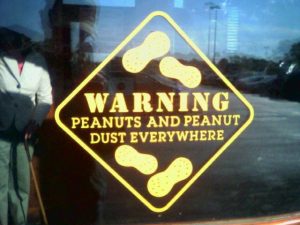This article contains affiliate links. If you make a purchase after clicking on a link I may earn a small commission at no extra cost to you.
Peanut Allergy is one of the most common food allergies and can be one the more serious to the extent of anaphylaxis, which is an acute allergic reaction to an antigen (e.g. a bee sting) to which the body has become hypersensitive.
Although peanuts are what many usually think of when talking about nut allergies, reactions can happen when any kind of nut is ingested (eg, walnuts, cashews, pecans, almonds etc.). Here we will discuss what you need to know about peanut allergies, keeping in mind that it may apply to all nuts.
Common Reactions to Expect from Peanut Allergies
Those who suffer from this type of allergy can have a mild or severe reaction to them. Time wise, an allergic reaction can be immediate, or delayed – as in, a few hours after ingestion. Following are some common body reactions these allergy sufferers may experience:
- Skin Reactions: Redness, swelling, hives, itchy rashes, etc. are all common skin reactions to peanut allergies. Skin reactions are the most common type of effect most nut allergy sufferers will experience.
- Gastrointestinal System: Peanut allergy sufferers may experience diarrhea, have severe stomach aches, nausea and/or vomiting after ingesting nuts.
- Respiratory Reactions Caused: Asthma-like symptoms can occur. These can range from watery eyes and stuffy, itchy noses to coughing, sneezing and wheezing.
- Cardiovascular Reactions: Lightheadedness and/or other symptoms of faint are common cardiovascular reactions.
Now that you know the common symptoms associated with peanut allergies, you may be wondering how it is diagnosed.
How to Diagnose a Peanut Allergy
There are several ways physicians test for this type of allergy. The most common method is conducted by an allergist, a physician who specializes in allergies.
The allergist will ask you a series of questions. These questions will range from your past reactions to nut ingestion, to your family history as it relates to allergies (eg, does anyone in your family suffer from nut allergies, or other food allergies). It is common for food allergies to run in families, so this is extremely useful information.
After this is done, the allergist will most likely conduct a skin test. This involves putting a very small amount of the nut in question (a liquid abstract of) on your skin to see how it reacts. If your skin reacts, (eg, turns reddish, gets raised, bumpy and/or exhibits signs of a rash), then you are considered allergic.
Peanut Allergies: You’re Allergic, Now What?
Once you’ve determined that you are allergic to peanuts, you can take concrete action. Most physicians advise simply avoiding the offending nut all together, as there are no cures for this type of allergy.
Medical Cautionary Alert for Peanut Allergy Sufferers
Avoiding peanuts can get tricky as many foods contain nut derivatives. It’s important to learn how to read food labels and ask how food is prepared when you eat out to avoid accidentally coming into contact with them.
Accepting the fact that you have a nut allergy is a life-style change; one your body depends on to stay healthy.
Consult your physician (allergist) about concrete steps you can take to avoid the dangers common to this type of allergy sufferer.
